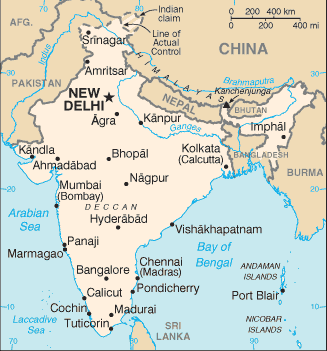India
Map Courtesy CIA World Factbook |
The Republic of India is a country in South Asia which comprises most of the Indian subcontinent. India has a coastline which stretches for over seven thousand kilometres, and shares its borders with Pakistan and Afghanistanon the northwest, the People's Republic of China, Nepal, and Bhutan on the north, and Bangladesh and Myanmar on the east. On the Indian Ocean, it is also adjacent to the island nations of the Maldives on the southwest, Sri Lanka on the south, and Indonesia on the southeast. India is the second most populous country in the world, with a population of over one billion, and is the seventh largest country by geographical area.
India is home to some of the most ancient civilisations (and a centre of important historic trade routes), including four major world religions: Hinduism, Buddhism, Jainism and Sikhism. Formerly a part of the British Empire before gaining independence in 1947, during the past two decades the country has grown significantly, in its economic and military roles, regionally as well as globally.
Stone Age rock shelters with paintings at Bhimbetka in Madhya Pradesh are the earliest known traces of human life in India. The first known permanent settlements appeared 9,000 years ago and developed into the Indus Valley Civilization, which peaked between 2600 BC and 1900 BC.
From around 500 BC onwards, many independent kingdoms came into being. In the north, the Maurya dynasty, which included the Buddhist king Ashoka, contributed greatly to India's cultural landscape. From 180 BC, a series of invasions from Central Asia followed, with the successive establishment in the northern Indian subcontinent of the Indo-Greek, Indo-Scythian and Indo-Parthian kingdoms, and finally the Kushan Empire. From the 3rd century onwards the Gupta dynasty oversaw the period referred to as India's "Golden Age".
Following the Islamic invasions in the beginning of the second millennium, much of India was ruled by the Delhi Sultanate, and later, much of the entire subcontinent by the Mughal dynasty. Nevertheless, several indigenous kingdoms remained in or rose to power, especially in the relatively sheltered south.
During the middle of the second millennium, several European countries, including the Portuguese, French, and English, who were initially interested in trade with India, took advantage of the fractured kingdoms to colonise the country. After a failed insurrection in 1857 against the British East India Company, popularly known as the First War of Indian Independence, most of India came under the direct administrative control of the crown of the British Empire. A prolonged and mostly non-violent struggle for independence, the Indian independence movement, followed, eventually led by Mahatma Gandhi, regarded officially as the father of modern India. On 1947-08-15 India gained independence from British rule, later becoming a republic on 1950-01-26.
As a multi-ethnic and multi-religious country, India has had its share of sectarian violence and insurgencies in different parts of the country. Nonetheless, it has held itself together as a secular democracy barring a brief period from 1975 to 1977 during which the then Prime Minister Indira Gandhi declared a "state of emergency" with the suspension of civil rights. India has unresolved border disputes with China, which escalated into a brief war in 1962, and Pakistan which resulted in wars in 1947, 1965, and 1971. India was a founding member of the Non-Aligned Movement. In 1974, India conducted an underground nuclear test, making it an unofficial member of the "nuclear club", which was followed up with a series of five more tests in 1998. Significant economic reforms beginning in 1991, have transformed India into one of the fastest growing economies in the world.

